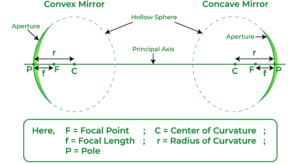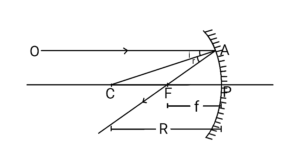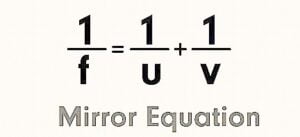
Angle of deviation ( δ ) :-
The passes of light through a triangular prism ABC, The angles of incidence and refraction at the first face AB are i₁ and r₁ while the angle of incidence at the second face AC is r₂ and the angle of refraction or emergence i₂ .
The angle between emergent ray QR and the direction of the incidence ray OP is called the angle of deviation δ.
In the quadrilateral APNQ, two of the angles at the vertices P and Q are right angles. Therefore, the sum of the other angles of the quadrilateral is 180⁰
∠A + ∠PNQ = 180⁰
From the triangle PNQ
r₁ + r₂ + ∠PNQ = 180⁰
Comparing these two equations, we get
r₁ + r₂ = A
The total angle of deviation δ is the sum of deviations at the two faces.
δ = ( i₁ – r₁ ) + ( i₂ – r₂ )
i.e.
δ = ( i₁ – i₂ ) – A
Refractive index of the prism :-
At the minimum angle of deviation δm, the refracted ray inside the prism becomes parallel to its base. We have
δ = δm
i₁ = i₂, r₁ = r₂
The equation r₁ + r₂ = A
Gives 2r = A
r = A/2
The equation δ = i₁ + i₂ = A
Gives δm = 2i – A
i = ( δm + A )/2
From Snell’s law, the refractive index of the prism is
μ = sin ( δm + A )/2 / sin A/2
Deviation produced by a thin prism :-
For small angle prism or a thin prism angle of deviation δm is very small, sin θ = θ
Hence,
μ = ( δm + A )/2 / A/2
μ = ( δm + A )/A
Aμ = δm +A
δm = ( Aμ – 1 ) A
Numerical questions.
- The angle of incidence for a ray of light at a refracting surface of a prism is 45⁰ . The angle of prism is 60⁰. The ray suffers minimum angle of deviation and refractive index of the material of the prism respectively are –
Solution.
A = 60⁰
δ = δm = i₁ = i₂ = 45⁰
δm = i₁ + i₂ ₋ A = 90⁰ – 60⁰
δm = 30⁰
Now,
μ = sin ( δm + A )/2 / sin A/2
= sin ( 60⁰ + 30⁰ )/2 / sin 60⁰/2
= sin 45⁰ / sin 30⁰
= 1/√2 / 1/2
= 2\√2
or μ = √2
2. A ray of light is incident at an angle of incidence i on one face of a prism of angle A ( assume to be small ) and emerges normally from the oppsite face, if the refractive index of the prism is μ, the angle of incidence i is nearly equal to –
μ = sin i/sin r = sin i/A
For small angle,
μ = i / A
Or i = μA





